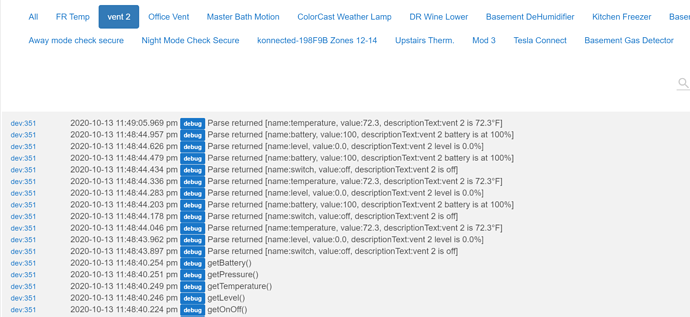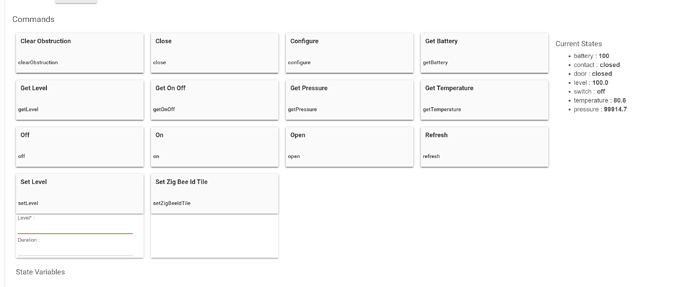I'll see if I still have my code around - I don't remember if I kept it or trashed it out of frustration when I threw all my keen vents in the dumpster. I know I deleted the code off all my hubs, so I'll have to see if I backed it up elsewhere. I do remember it took me a few tries to get the temp reporting right, just don't remember what I had to do in the end.
Did you replace them w/another smart vent, or decided to go back to normal vents?
Normal vents.
the vent is pretty usefull for me.. i have a lot of computer equip. in a spare room. including mail/dns server with 24 cores etc. it gets hot. i have a window ac that turns on auto. with fan. and i want the vent to open when the normal ac is on and off when the heat is on.. ie temp sensor in the vent has been working great for me.. and at least for me my batteries last over a year.
It's good to hear a good experience. I'm thinking about including smart vents as part of a remodel we're going to do, but a bit leery based on comments like @JasonJoel's and others I've seen...
I wouldn't. Too many people with the same experience as me (horrible battery life) / too big of a cost gamble based on that.
I have Keen vents, and they have not eaten batteries like others, however...
They are by far the most finicky part of my automation. I have 1 that is always being obstructed, but I have no idea it is because it always says it moved, even when it doesn't. The lack of sizes hurts me in some places. Most of the time the proportionality of the louvres does little for me.
If I were to do it again, I would get some proper duct shutoff dampers, and figure out how to automate those. But I know with this there is a pressure relief return that should be installed.
Same here. If I decide I need more control, it will be via positional duct damper controllers.
I'm planning on a remodel in a couple years - this is definitely on the cards!
Most of mine have been going strong for quite some time, almost all of them are hardwired though, and the couple I have left that I haven't converted yet have been lasting well over six months or better on the stock driver and batteries. For me, it was way cheaper to spend the money on the Keens vs separate dampers for everything. I use a custom code for the vent control and I am probably adjusting the vents at a much higher frequency than the Keenlight code and the battery ones still seem to last quite a while.
are u successfully reading the vent temp and pressure
I was using a different driver on one of the vents to read them, but the readings seemed pretty useless. Right now all (16) but one vent is on the stock HE driver
OK I figured it out and fixed it in hubitat.. here is my new driver which shows correct temp and pressure.
// lgk 10/20 had to modify by calling this function to get the corrected description map in Hubitat.. This was not necesary in Smartthings so something is different in the underlying achitecture.
// zigbee.parseDescriptionAsMap(description)
this wes necessary even before reversing the bytes.
the results were as follows (example first is pressure, second is temp)
new map = [raw:5D760104030C200022E93E0F, dni:5D76, endpoint:01, cluster:0403, size:0C, attrId:0020, encoding:22, command:0A, value:0F3EE9, clusterInt:1027, attrInt:32]
orig map = [raw:5D760104030C200022E93E0F, dni:5D76, endpoint:01, cluster:0403, size:0C, attrId:0020, encoding:22, command:0A, value:E93E0F]
Corrected map = [raw:5D760104020C000029AD08, dni:5D76, endpoint:01, cluster:0402, size:0C, attrId:0000, encoding:29, command:01, value:08AD, clusterInt:1026, attrInt:0]
orig map = [raw:5D760104020C000029AD08, dni:5D76, endpoint:01, cluster:0402, size:0C, attrId:0000, encoding:29, command:01, value:AD08]
mple, first is pressure second is temp)
Anyway here is the github
make sure to hit configure after changing drivers..
Running your previous version of the driver, and I noticed that it always reports that it opened/closed regardless of it actually opening/closing. I didn't realize this and it made my test run worthless, haha. I take it there's no confirmation built into your driver at all? I was able to go back through the logs and see the last crazy temperature reading and my batteries lasted from 9/29 to 10/11. I think that's actually worse than the stock driver. 
The new.one has fixed for temps and open close always works mow. Why are you running old version.
Hi everyone,
We recently installed a new furnace and A/C system. 2-stage high efficiency heating and cooling. To make the most of the investment I decided to see what I could do about evening out the temperatures throughout the house. Generally in the summer the finished basement (family room, one bedroom, one bathroom) is freezing, even with the vents closed, while the upstairs at the end of the main duct run takes a while to cool down. In the winter the basement becomes an oven and the far bedrooms are freezing.
I've been trying my best over the last 10 days to get Flair vents and Ecobee working with SmartThings and automating it with WebCoRE. While for the most part it works, the delays between the command being issued, the Flair vent opening or closing, and the values being updated in SmartThings for WebCoRE to detect a change are unacceptable. 5 to 10 minutes is to long to get the updated status of the vents at the end of the house so I can make sure the duct booster fan is switched off if the vents are closed.
I've decided to send all of the Flair stuff, and the SmartThings hub back.
Thus the search began for an off-line locally processed system. So here I am. 
After doing some research I've ordered,
- A Hubitat
- Keen vents
- Aqara Temperature sensors (which look a LOT like the Keen sensors, but $10 less)
- Zen Thermostat
- Centralite Smart Outlet (to control the duct booster fan)
None of the above are dependent on having an internet connection.
I'll be using whatever drivers give me direct control to read the temp sensors, control the mode and setpoint of the thermostat, open/close the vents and turn on/off the booster fan. I'll be crafting the automation myself to run on the Hubitat.
Am I headed the right direction here, or am I chasing rainbows?
It sounds like the basement is getting too much airflow all year. You may not need to be able to dynamically adjust vents to solve this problem. Manual dampers that restrict the flow to the basement registers should be your first step.
If you are planning on powering these using batteries, be aware that multiple individuals have observed them to have ridiculously short battery life (like ~2 weeks). It would be prudent to hardwire 3V DC power to them.
Must say from a HVAC reliability perspective, I would rather have motorized dampers.
Dampers wouldn't help the basement, or any other part of the house really as the main duct runs in a straight line the length of the house and goes directly through there. The vents in the basement are straight off of that main duct. There are a couple of spots where I suspect there are duct leaks, and one spot that I know there is a "mess" with probably a lot of leaks. Previous contractors that did the addition to the house apparently didn't want to, or couldn't find an adapter to go from 8" square vent to 8" round vent, so they attempted to make one out of 1/4" plywood. Gonna have to rip that out and do it properly for sure.
My plan is to close the basement vents when heating/cooling, and let the upstairs get close to temp, then turn off the heating/cooling and run the duct booster fan pulling that extra heat/cool up into the bedrooms. After fixing the known leaks I suspect this will work better, but at the moment it does fine with the Flair system if I do it all manually. The automation script worked as expected, but the lag times for web services was just to high.
If you have bad leaks from your ducts into your basement, I don't see how anything you do with controllable vents would help that. A duct booster downstream of the leak might make it a little less bad by slightly decreasing the pressure in the duct near the leak. Fix the leaks first. Then, see how the system performs and whether additional tuning is needed.



